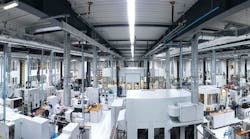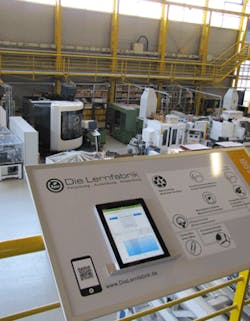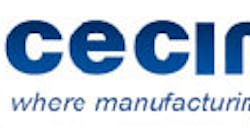Everyone’s talking about sustainability and energy-efficiency. But, for manufacturers, such idealistic goals cannot be pursued apart from their production objectives. Sustainability —using a ‘regenerable’ system so that its essential characteristics are preserved — has to focus on the entire value-creation chain.
At EMO Hannover 2013, September 16-21, several presentations will seek to demonstrate how sustainable production, or sustainable manufacturing, from raw materials to recycling, will secure global competitiveness for the organizations that achieve it.
For example, in the forestry sector, the producers have understood for centuries that they must not fell more trees than can be replaced by new growth. This principle of sustainability is being adopted in modern manufacturing technology, and is fitting that it will be reflected in the motto of the EMO Hannover 2013, “Intelligence in Production”.
“For more and more manufacturing companies, ecological efficiency is the obvious complement to economic efficiency,” observed Prof. Dr.-Ing. Christoph Herrmann, an executive board member of the Institute for Machine Tools and Production Technology (IWF) at Brunswick University of Applied Science.
“But,” Herrmann continued, “changes towards sustainable production are possible only if the product’s entire lifecycle — from raw material procurement, part manufacture and assembly, actual use, all the way through to final disposal, is taken into due account.”
Without such a perspective, “potentials can easily be overlooked, or worse, problems merely relocated from one phase in the lifecycle to another.”
The reason for the latter is that when discussing the entire value -creation chain of a product, “we have to think in terms of beginning-to-end, or complete product and material lifecycles,” explained Herrmann, who at the IWF heads the Product und Lifecycle Management Department. In addition, he also is the academic executive director and a member of the board at Lower Saxony’s Vehicle Technology Research Centre (NFF.)
Sustainability Principle, Properly Applied
Competitiveness remains the paramount goal of any enterprise. Green does not sell. And, aside from price, a product’s quality and function continue to demand an appropriate focus from the manufacturer. Weaknesses on these points cannot be made good by an ecologically sustainable production operation.
Herrmann summarized the importance of sustainability for innovation this way: “Innovation usually needs drivers. We’re already seeing today how rising energy costs are triggering many new technical and organizational solutions, in terms of either new factory concepts, more efficient drives or in metrological applications and energy management.”
Moreover, when the sustainability principle is properly applied, the user benefits, too – twice over: “Firstly, he receives a product that has been produced with both economic and ecological efficiency,” according to Hermann. “And secondly, since for energy-operated products in particular, a substantial proportion of the lifecycle costs and the environmental impact are linked to the utilization phase, the user benefits from the fact that the product he has purchased requires less energy and consumables compared to any alternative product – without any loss of quality or functional efficacy.”
You’d like some actual fully functioning examples? “Let’s take the Brunswick region,” the professor offered. “In the zero-emissions factory of the Solvis company, 14,000 square meters featuring offices, warehouses, and production zones are supplied entirely with renewable energies from in-house systems. It’s a holistic concept for the factory, covering the building’s shell, its technical systems, and the machinery and lines it houses, has been implemented here with exemplary rigor.”
Solvis produces solar heating systems and wood-pellet boilers, for example, and through its own products also contributes towards sustainable development.
Another regional example is Volkswagen: “With its ‘Think Blue Factory’ initiative, all measures aimed at improving energy-economy and resource-efficiency are being synergized.” The target is a 25 percent reduction in environmental impact by 2018. One very specific example is the Energy Path at the plant in Wolfsburg, where any measures implemented are rendered visible for the staff. Of course,” Herrmann said, “there are fully functioning examples not only in our own region.”
One project is particularly close to the professor’s heart: “The (green) learning factory at Brunswick University of Applied Science supports the transfer of research results to operational reality.” It focuses on the practical “experiential relevance” of methods, tools, and technologies in the fields of energy-economy and resource-efficiency, and on raising awareness among specialists and managerial staff, but also among students or trainees as future drivers and ‘influencers’.”
Urban Design for Manufacturing
One example of sustainability already validated in practice is Wittenstein Bastian GmbH’s low-noise, low-emissions manufacturing plant for gearing solutions in Fellbach, Germany, inaugurated early in 2012.
“Here in Fellbach, we have built a demonstration factory in which, step by step, we shall be progressing exemplary integration of the concepts laid down in Industry 4.0,” explained Dr. Manfred Wittenstein, managing board chairman of Wittenstein AG.
“The idea is that in the future machines, production equipment, and semi-finished products will be continuously interlinked via the Internet, so that you can alter the specification of a gearwheel at the last minute, for example. The preconditions for gradually integrating into the processes elements of a future-friendly ‘thinking’ production operation – known as cyber-physical systems - are thus in place. This development thrust towards Industry 4.0 also contributes towards securing the future of Germany’s industrial base,” Wittenstein said.
Wittenstein Bastian new urban production facility is quite something: the building automation system and the machinery have been designed to minimize resource consumption, coupled with maximized precision. All eco-relevant issues -- like noise, flue gas, waste, CO2 emissions, water and effluent -- are just as exhaustively addressed as architectural integration into the residential environment directly adjoining the facility. And, although the new production plant is fully air-conditioned, in comparison to the old building, around 35 percent of energy costs per square meter are saved.
“Integrating a factory into a densely populated urban environment was a major challenge,” said the two general managers, Philipp Guth and Michael Müller. “You have to make do with limited space, you want to avoid creating any pollution, and you also want maximized energy-efficiency and resource-economy, so as to minimize the impact on human beings and the natural environment.”
Innovation Driver
The manufacturing technology sector is not new to the imperatives of sustainability. Two years ago Cecimo, the European machine tool builders’ consortium, and VDMA, the German machine tool builders association, established a cooperative initiative to promote and certify sustainability in their members products and processes.
At EMO in September, the Blue Competence sustainability initiative will be showcasing its capabilities. Machine tool manufacturers and their component suppliers will be exhibiting the latest results of their research and development work themed around the issues of energy-efficiency and resource-economy. At a dedicated technical forum, sustainability-related activities also will also be explained and discussed.
Blue Competence is the platform by which European manufacturing technology suppliers are coordinating their strengths and know-how, so as to secure and maintain long-term leadership in issues of sustainability. Their message is that on the subject of sustainability, the mechanical engineering sector is ‘the enabler’ for both sustainable production and sustainable products.
Professor Herrmann formulated his expectations for EMO as follows: “The environmental issue as a driver of innovations will be placed in a systematized context here.”
The “More Intelligent Production” congress is also sure to arouse keen interest. Besides lean production and Industry 4.0, the focus will be on sustainable production. The issues of energy-economy and resource-efficiency have been taken on by many manufacturers and are being reflected in specific technical innovations and new services. These include software tools, for example, and the relevant control technology for adapting process parameters, so as to run a process at maximum energy-efficiency or to put machines into an “energy-saving mode” quickly, since power consumption will sometimes still be substantial when the machine is not actually producing anything.
“And, without a doubt, one or two exhibitors will be positioning themselves in anticipation of the upcoming ISO 14955 for the environmental assessment of machine tools,” Prof. Herrmann noted.
Walter Frick is a journalist in Weikersheim, Germany, who specializes in subjects relating to manufacturing technology.








